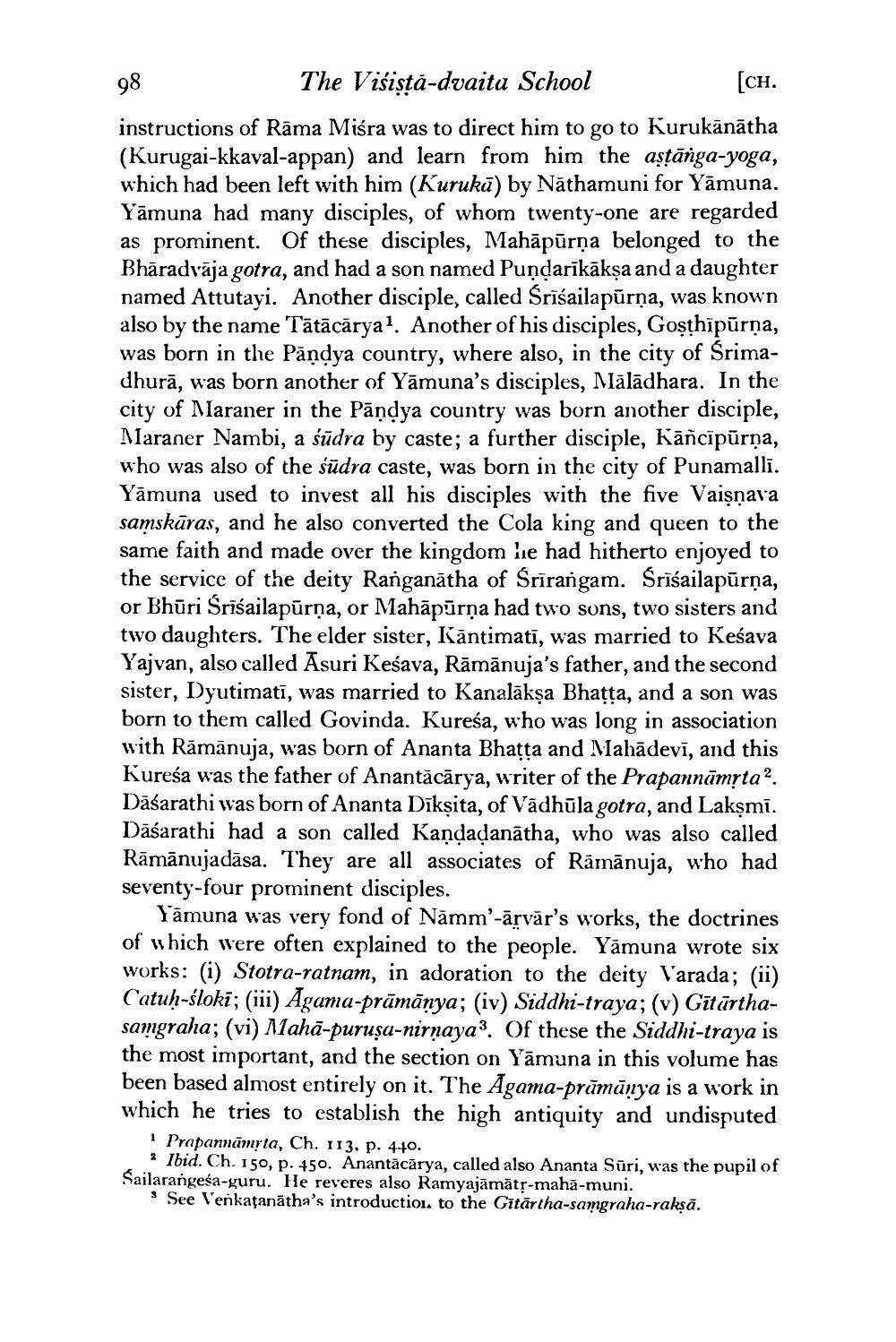________________
98
The Visista-dvaita School
(ch. instructions of Rāma Miśra was to direct him to go to Kurukānātha (Kurugai-kkaval-appan) and learn from him the astānga-yoga, which had been left with him (Kurukā) by Nāthamuni for Yamuna. Yāmuna had many disciples, of whom twenty-one are regarded as prominent. Of these disciples, Mahāpūrņa belonged to the Bhāradvāja gotra, and had a son named Pundarīkākṣa and a daughter named Attutayi. Another disciple, called Śrīsailapūrņa, was known also by the name Tātācāryal. Another of his disciples, Gosthīpūrņa, was born in the Pandya country, where also, in the city of Srimadhurā, was born another of Yāmuna's disciples, Mālādhara. In the city of Maraner in the Pāņdya country was born another disciple, Naraner Nambi, a šūdra by caste; a further disciple, Kāñcīpūrņa, who was also of the sūdra caste, was born in the city of Punamallī. Yāmuna used to invest all his disciples with the five Vaişnava samskūras, and he also converted the Cola king and queen to the same faith and made over the kingdom he had hitherto enjoyed to the service of the deity Ranganātha of Śrīrangam. Śrīśailapūrņa, or Bhūri Srisailapūrna, or Mahāpūrna had two sons, two sisters and two daughters. The elder sister, Kántimatī, was married to Keśava Yajvan, also called Asuri Keśava, Rāmānuja's father, and the second sister, Dyutimatī, was married to Kanalākṣa Bhatta, and a son was born to them called Govinda. Kuresa, who was long in association with Rāmānuja, was born of Ananta Bhatta and Mahādevī, and this Kuresa was the father of Anantācārya, writer of the Prapannūmrta?. Dāśarathi was born of Ananta Dīksita, of Vadhūla gotra, and Lakşmi. Dāśarathi had a son called Kandadanātha, who was also called Rāmānujadāsa. They are all associates of Rāmānuja, who had seventy-four prominent disciples.
Yāmuna was very fond of Nămm'-ārvār's works, the doctrines of which were often explained to the people. Yămuna wrote six works: (i) Stotra-ratnam, in adoration to the deity Varada; (ii) Catuh-ślokī; (iii) Agama-prāmānya; (iv) Siddhi-traya; (v) Gītārthasamgraha; (vi) Mahā-purușa-nirnaya3. Of these the Siddhi-traya is the most important, and the section on Yāmuna in this volume has been based almost entirely on it. The Agama-prāmānya is a work in which he tries to establish the high antiquity and undisputed
Prapannāmrta, Ch. 113, p. 440. ? Ibid. Ch. 150, p. 450. Anantācārya, called also Ananta Sūri, was the pupil of Sailarangesa-guru. He reveres also Ramyajāmātr-mahă-muni.
* See Venkatanātha's introduction to the Gitārtha-samgraha-raksā.




